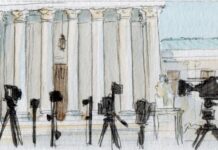OPINION ANALYSIS
on Jun 16, 2022
at 10:45 am

Wednesday’s decision in Ysleta del Sur Pueblo v. Texas resolves a longstanding dispute about the ability of Texas to control gambling on the lands of two of the Native American tribes that reside there. The answer the court gave was a stern rebuke, vitiating the plenary control that lower-court decisions had granted the state for more than a quarter of a century.
The problem involves the odd history of two of the three Native American tribes that remain in the state of Texas, the petitioner Ysleta del Sur Pueblo (a tiny reservation near El Paso) and the much larger Alabama-Coushatta reservation in East Texas. Although almost all Native American tribes in the United States operate under a trust relationship with the federal government, those two tribes were in a trust relationship with Texas from 1968 to 1987. When Texas authorities decided that their state constitution did not permit that relationship, Congress restored a federal trust relationship for those tribes by passing the Restoration Act in 1987. The most controversial provisions of that statute, addressed in Ysleta, are the provisions that govern the tribes’ subjection to Texas gambling regulations.
The basic problem is how to reconcile one provision, which bars gambling activity “prohibited†by Texas law, with another provision, stating that the statute is not “a grant of civil or criminal regulatory jurisdiction to the State of Texas.†The lower courts quickly allowed Texas to act under those provisions to subject tribal operations to the full range of its regulations. In this case, for example, the state successfully challenged the operation of bingo by the Pueblo that does not follow the details of Texas’ regulations on that subject. Justice Neil Gorsuch’s opinion for the court squarely rejects that understanding.
For Gorsuch, “the most striking feature about th[e statutory] language is its dichotomy between prohibition and regulation.†Specifically, as he puts it, the first provision “says that gaming activities prohibited by state law are also prohibited as a matter of federal law (using some variation of the word ‘prohibited’ no fewer than three times).†Conversely, the second provision “insists that the statute does not grant Texas civil or criminal regulatory jurisdiction with respect to … gaming.â€
Gorsuch starts with “a careful look at the statute’s terms standing on their own.†Quoting from an assortment of dictionaries, he suggests that “to prohibit something means to ‘forbid,’ prevent,’ or ‘effectively stop’ it, or ‘make [it] impossible.’†In contrast, dictionaries that he quotes suggest that “to regulate something is usually understood to mean to ‘fix the time, amount, degree, or rate’ of an activity ‘according to rule[s].’â€
Gorsuch sees those definitions as “a problem†for Texas. The dispute in this particular case involves bingo, and Texas “concedes that its laws do not forbid, prevent, effectively stop, or make bingo impossible.†Bingo in fact is quite common in Texas, “subject to fixed rules about the time, place, and manner in which it may be conducted.†For Gorsuch, “it would seem to follow that Texas’s laws fall on the regulatory rather than prohibitory side of the line – and thus may not be applied on tribal lands.â€
Gorsuch acknowledges Texas’ textual argument – “in everyday speech someone could describe its laws as ‘prohibiting’ bingo unless the State’s time, place, and manner regulations are followed.†Gorsuch offers several responses. Most prominently, he says, “it risks rendering the Restoration Act a jumble.†For Gorsuch, it is plain – “[n]o one questions†– “that Texas ‘regulates’ bingo by fixing the time, place, and manner in which the game may be conducted.†So if the court accepts that “in some sense†Texas also prohibits bingo, “the law’s dichotomy between prohibition and regulation collapses†because “[l]aws regulating gaming activity become laws prohibiting gambling activities.†From that point, Gorsuch reasons that acceptance of Texas’ argument would leave the bar on regulatory jurisdiction “with no work to perform, its terms dead letters all.â€
Perhaps more devastating are the “contextual clues†Gorsuch discusses in the next section of the opinion. First is the Supreme Court’s 1987 decision in California v. Cabazon Band of Mission Indians, which distinguished between types of gambling that a state prohibits outright (craps, for example) and those that it permits subject to regulation (bingo, in the Cabazon example, “laws materially identical to the Texas bingo laws before us todayâ€). In Cabazon, interpreting a regulatory regime for Native American reservations that does not apply under the Restoration Act, the court held that California could regulate the gambling it prohibited outright, but, crucially, that it could not regulate gambling like bingo that it permits on specified terms and conditions. “For us, [Cabazon] clinches the case.†Because Cabazon “was not only a relevant precedent concerning Indian gaming; it was the precedent, …. [w]e do not see how we might fairly read the terms of the Restoration Act except in the same light.â€
Although Gorsuch describes the case as clinched, he goes further to emphasize two other statutes contemporaneous with the Restoration Act. One, adopted the same day as the Restoration Act, subjected a tribe to “those laws and regulations which prohibit or regulate the conduct of bingo or any other game of chance.†Another, adopted “[s]hortly after the Restoration Act,†provided that “all laws … and regulations of the State … shall govern the regulation of gambling … by the Tribe on and off the Reservation.†For Gorsuch, the choice “to use the language of Cabazon in different ways in three statutes closely related in time and subject matter [is] too much to ignore.â€
The opinion includes several more pages rejecting a variety of historical and policy arguments that Texas advanced, but the foregoing should give an adequate understanding of the motivation of Gorsuch’s opinion. To put the decision in context, it probably is not a coincidence that the 5-4 lineup parallels the lineup in the court’s most important Native American case of the millennium, McGirt v. Oklahoma, which recognized a reservation continuing to cover the eastern half of Oklahama. The only difference is that, in McGirt, the late Justice Ruth Bader Ginsburg joined Gorsuch’s majority opinion. Now, Ginsburg’s successor, Justice Amy Coney Barrett, has joined Gorsuch and the three remaining liberal justices in Ysleta. The dissenters have remained the same in both cases: Chief Justice John Roberts and Justices Clarence Thomas, Samuel Alito, and Brett Kavanaugh. Time will tell if the stability of the cross-ideological Ysleta majority presages a broader recognition of protections for Native Americans than the cases of the past several decades have seen. The next big clue will come in the next few weeks when the court decides Oklahoma v. Castro-Huerta, a sequel to McGirt in which Barrett likely will be the swing vote.





